原型基于颜色的图像检索与MATLAB
- 格式:doc
- 大小:1.13 MB
- 文档页数:22
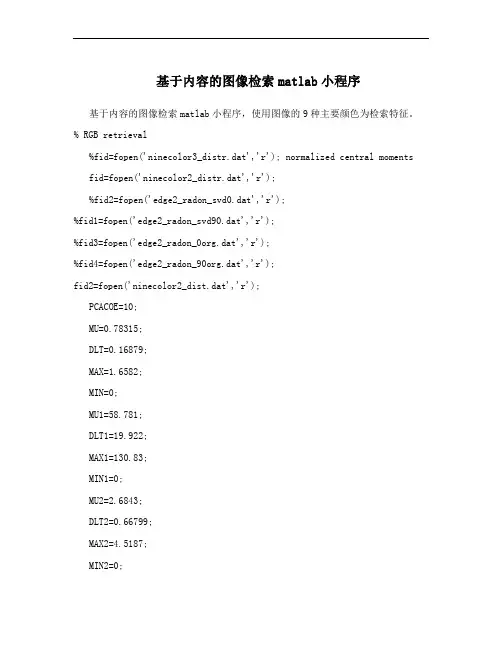
基于内容的图像检索matlab小程序基于内容的图像检索matlab小程序,使用图像的9种主要颜色为检索特征。
% RGB retrieval%fid=fopen('ninecolor3_distr.dat','r'); normalized central moments fid=fopen('ninecolor2_distr.dat','r');%fid2=fopen('edge2_radon_svd0.dat','r');%fid1=fopen('edge2_radon_svd90.dat','r');%fid3=fopen('edge2_radon_0org.dat','r');%fid4=fopen('edge2_radon_90org.dat','r');fid2=fopen('ninecolor2_dist.dat','r');PCACOE=10;MU=0.78315;DLT=0.16879;MAX=1.6582;MIN=0;MU1=58.781;DLT1=19.922;MAX1=130.83;MIN1=0;MU2=2.6843;DLT2=0.66799;MAX2=4.5187;MIN2=0;%fid1=fopen('avecolor.dat','r'); %for (i=1:910)% tmp_mom=fread(fid1,10,'float'); % ind12(:,i)=tmp_mom(1:PCACOE); % tmp_mom=fread(fid2,10,'float'); % ind13(:,i)=tmp_mom(1:PCACOE); %end %ind_pca0=ind12';%ind_pca90=ind13';%fclose(fid1);%fclose(fid2);%for (i=1:910)% tmp_mom=fread(fid3,128,'float'); % ind14(:,i)=tmp_mom(1:128); % tmp_mom=fread(fid4,128,'float'); % ind15(:,i)=tmp_mom(1:128); %end %ind_0org=ind14';%ind_90org=ind15';%fclose(fid3);%fclose(fid4);for (i=1:910)hist1(:,i)=fread(fid2,18,'float'); endind_dis=hist1';fclose(fid2);for (i=1:910)hist(:,i)=fread(fid,63,'float'); endind_c=hist';fclose(fid);NULL_seg=[0 0 0 0 0 0 0];isize=910;qi=1;dist1=0;qi=input('Query image no:(1-910 or 0 to quit)');while (qi~=0)qh=ind_c(qi,:);for (cnt=1:910)dist=0;db=ind_c(cnt,:);for (j=1:9)%% L1/L2 Distancestmp_vec=qh((j-1)*7+1:j*7);tmp_vec1=db((j-1)*7+1:j*7);%if ((tmp_vec==NULL_seg)|(tmp_vec1==NULL_seg))%% if (sum(tmp_vec(4:6))~=0) %% angl=1-(2/pi)*acos(abs(tmp_vec(4:6)*tmp_vec1(4:6)'));%% else%% angl=0;%% end%% if (angl<0)%% angl=0;%% end%dist=dist+norm(tmp_vec(1:3)-tmp_vec1(1:3),2)+angl+abs(tmp_vec(7)-tmp_vec1(7));dist=dist+norm(tmp_vec(1:6)-tmp_vec1(1:6),2)+abs(tmp_vec(7)-tmp_vec1(7));%dist=dist+norm(tmp_vec-tmp_vec1,1);end% Distance of SVD coefficients%%dist1=0.5*(norm(ind_pca90(qi,:)-ind_pca90(cnt,:),2)+norm(ind_pca0(qi,:)-ind_pca0(cnt,:),2));%%dist2=0.5*(norm(ind_90org(qi,:)-ind_90org(cnt,:),2)+norm(ind_0org(qi,:)-ind_0org(cnt,:),2));%% New distance%%DIST=0;%% for (k=1:9)%% DIST=DIST+qh(k*7)^2;%5 end%% for (j=1:9)%% DIST=DIST+db(j*7)^2;%% end%% for (k=1:9)% for (j=1:9)% tmp_arr=db((j-1)*7+1:j*7);%% d1=norm(qh((k-1)*7+1:(k-1)*7+6)-tmp_arr(1:6),2); % if (d1>0.08)% a1=0;% else% a1=1-d1/0.096;% end% DIST=DIST-2*a1*qh(k*7)*tmp_arr(7);%dist00(k,j)=norm(query0((k-1)*4+1:(k-1)*4+3)-tmp_arr(1:3),2)+sum(abs(query0(k*4)-tmp_arr(4)));%dist00(k,j)=sum(abs(query0((k-1)*4+1:(k-1)*4+4)-tmp_arr(1:4)));%%dist00(k,j)=norm(query0((k-1)*4+1:(k-1)*4+3)-tmp_arr(1:3),1)+(1-min(query0(k*4),tmp_arr(4))/max(query0(k*4),tmp_arr(4)));%%dist01(k,j)=norm(query0((k-1)*2+1:k*2)-tmp_arr(1:2),2);%dist01(k,j)=norm(ind_ctroid(qi,(k-1)*2+1:k*2)-ind_ctroid(cnt,(j-1)*2+1:j*2),2);%%dist02(k,j)=norm(hsv_pca0(q_no+k-1,:)-hsv_pca0(db_no+j-1,:),2)+norm(hsv_pca90(q_no+k-1,:)-hsv_pca90(db_no+j-1,:),2);%% end%% end%% dist=DIST;dist1=norm(ind_dis(qi,:)-ind_dis(cnt,:),1);%dist=0.0*dist+1.0/1*(dist1-(MU-3*DLT))/(6*DLT);%dist=0.0*dist+1.0/1*(dist1-MIN)/MAX; dist2=0;dist=1.0*(dist-(MU2-3*DLT2))/(6*DLT2)+0.0*(dist1-(MU1-3*DLT1))/(6*DLT1)+0.0*dist2;result(:,cnt)=[dist cnt]';end%查询结果显示format short g;result1=result';%result2(:,1)=result1(:,2);%result2(:,2)=result1(:,1);result2=sortrows(result1);%disp(result2(isize-9:isize,:)); disp(result2(1:10,:));%Display first ten IMAGESpause;%name=input('Search image:','s'); i=0;%figure;rank=1;%for (k=isize:-1:isize-9)wh=figure;set(wh,'Color',[0.8 0.8 0.8]);set(wh,'Units','Normal');set(wh,'Position',[0.05 0.05 0.9 0.8]); set(wh,'MenuBar','none'); for (k=1:50)bmpno=round(result2(k,2)-1);iname=sprintf('f:\\image\\img\\%d.jpg',bmpno);[img map]=imread(iname);if (isrgb(img))[img map]=rgb2ind(img,256);endimg=imresize(img,[200 256]); %[128 128]hdl=subplot(5,10,rank);sv=strcat('',num2str(result2(k,1)));% frno=ceil(k/10);% fcno=mod(k,10);% if (fcno==0)% fcno=10;% end%subimage((frno-1)*0.1,(fcno-1)*0.1,img,map);subimage(img,map);%%set(hdl,'Units','Pixels');%%set(hdl,'Position',[0.05+mod(rank-1,10)*0.09 0.95-(floor((rank-1)/10)+1)*0.18 0.09 0.18]);%%lh=get(hdl,'Xlabel');%%set(lh,'String',sv);set(hdl,'Title',text('String',sv));posxy=get(hdl,'Position');%%set(gcf,'Units','normalized');rfcbox=uicontrol(gcf,'Style','Checkbox','Units','normalized',...'Position',[posxy(1) posxy(2)-0.02 0.086 0.052],...'String','RF=N','CallBack','my_rf');%% ['set(gca,"RF","N"),','if get(rfcbox,"Value")==1,', 'set(gca,"RF","Y"),','end'] 'String','Box=on',...set(hdl,'YTickLabel',[]),set(hdl,'XTickLabel',[]);%set(hdl,'YGrid','off'),set(hdl,'XGrid','off');set(hdl,'YTick',[]),set(hdl,'XTick',[]);set(hdl,'Box','off');rank=rank+1;end%end%flopsqi=input('Query image no:(1-110 or 0 to quit)');end。
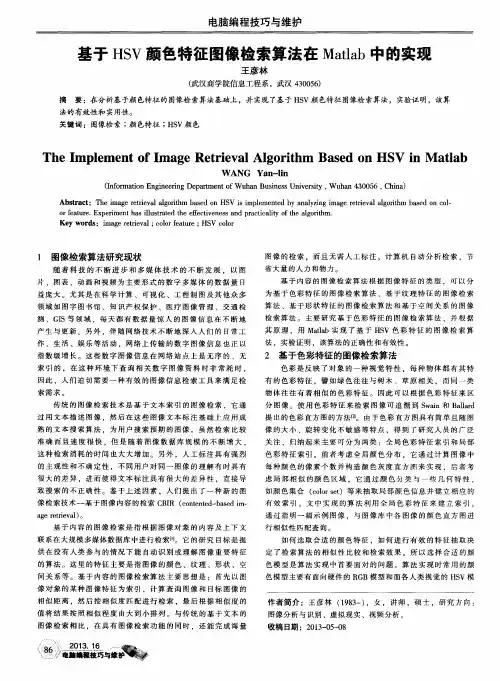
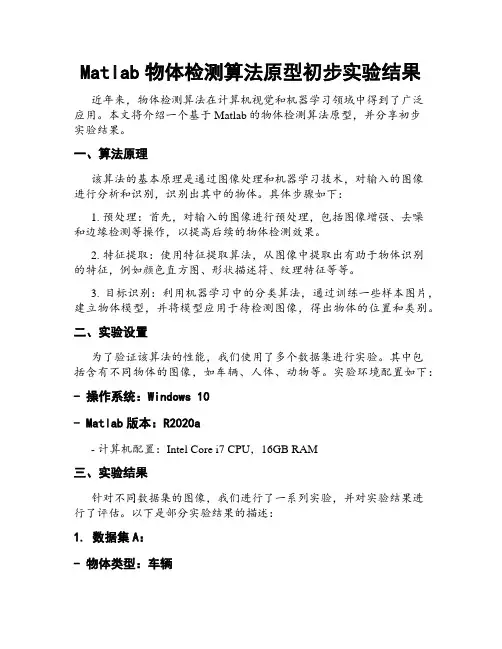
Matlab物体检测算法原型初步实验结果近年来,物体检测算法在计算机视觉和机器学习领域中得到了广泛应用。
本文将介绍一个基于Matlab的物体检测算法原型,并分享初步实验结果。
一、算法原理该算法的基本原理是通过图像处理和机器学习技术,对输入的图像进行分析和识别,识别出其中的物体。
具体步骤如下:1. 预处理:首先,对输入的图像进行预处理,包括图像增强、去噪和边缘检测等操作,以提高后续的物体检测效果。
2. 特征提取:使用特征提取算法,从图像中提取出有助于物体识别的特征,例如颜色直方图、形状描述符、纹理特征等等。
3. 目标识别:利用机器学习中的分类算法,通过训练一些样本图片,建立物体模型,并将模型应用于待检测图像,得出物体的位置和类别。
二、实验设置为了验证该算法的性能,我们使用了多个数据集进行实验。
其中包括含有不同物体的图像,如车辆、人体、动物等。
实验环境配置如下:- 操作系统:Windows 10- Matlab版本:R2020a- 计算机配置:Intel Core i7 CPU,16GB RAM三、实验结果针对不同数据集的图像,我们进行了一系列实验,并对实验结果进行了评估。
以下是部分实验结果的描述:1. 数据集A:- 物体类型:车辆- 实验结果:在100张测试图像中,平均准确率为85%。
大多数情况下,算法能够准确地检测出车辆的位置和类别。
2. 数据集B:- 物体类型:行人- 实验结果:在200张测试图像中,平均准确率为78%。
算法对于正面和侧面的行人识别效果较好,但对于背对相机的行人识别效果较差。
3. 数据集C:- 物体类型:动物- 实验结果:在50张测试图像中,平均准确率为92%。
算法能够准确地检测出动物的位置和类别,对于不同种类的动物表现出较好的泛化能力。
四、实验讨论根据实验结果,我们可以得出以下几点讨论:1. 该算法在不同数据集上的准确率存在一定差异,这可能是由于不同物体的外观特征和背景干扰的差异导致的。
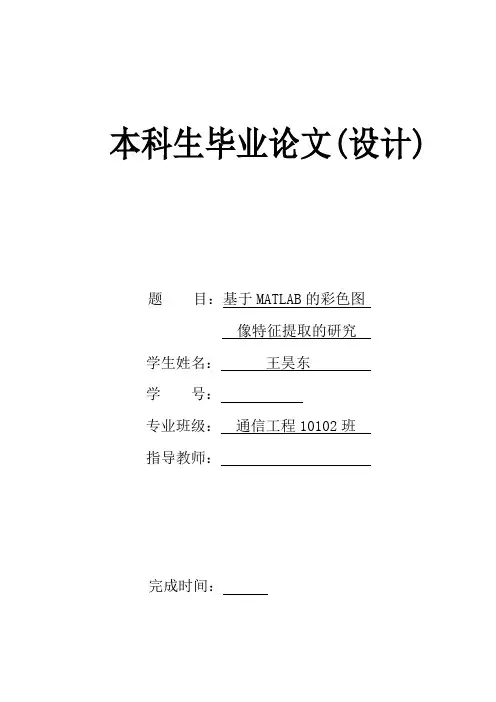
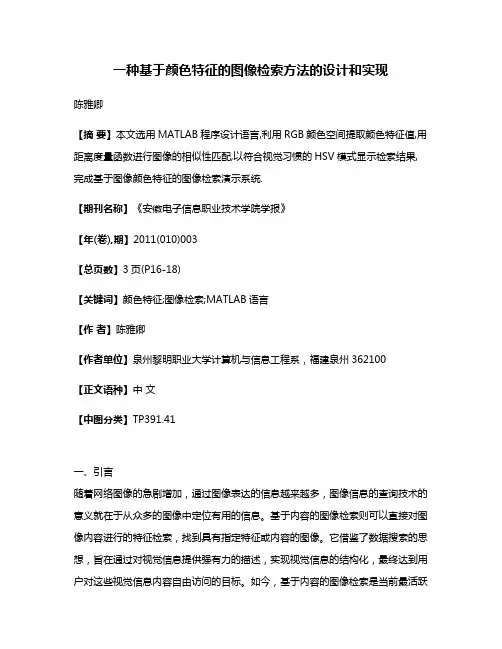
一种基于颜色特征的图像检索方法的设计和实现陈雅卿【摘要】本文选用MATLAB程序设计语言,利用RGB颜色空间提取颜色特征值,用距离度量函数进行图像的相似性匹配,以符合视觉习惯的HSV模式显示检索结果,完成基于图像颜色特征的图像检索演示系统.【期刊名称】《安徽电子信息职业技术学院学报》【年(卷),期】2011(010)003【总页数】3页(P16-18)【关键词】颜色特征;图像检索;MATLAB语言【作者】陈雅卿【作者单位】泉州黎明职业大学计算机与信息工程系,福建泉州362100【正文语种】中文【中图分类】TP391.41一、引言随着网络图像的急剧增加,通过图像表达的信息越来越多,图像信息的查询技术的意义就在于从众多的图像中定位有用的信息。
基于内容的图像检索则可以直接对图像内容进行的特征检索,找到具有指定特征或内容的图像。
它借鉴了数据搜索的思想,旨在通过对视觉信息提供强有力的描述,实现视觉信息的结构化,最终达到用户对这些视觉信息内容自由访问的目标。
如今,基于内容的图像检索是当前最活跃的研究热点之一。
以图像特征为索引对静态图像进行检索是目前使用最多的方法。
主要思想是根据图像的颜色、纹理、形状特征以及语义特征等内容特征作为图像的索引,计算查询图像与目标图像的相似距离,按相似度匹配进行检索。
(1)对颜色的空间分布是人类判断图像的最初印象,因此颜色通常是图像中最为显著的特征。
颜色是描述一幅图像最简便而有效的特征,(2)纹理特征是图像的重要信息和特征,是一种全局特征,它描述了图像或图像区域所对应的景物的表面性质,包括表面结构组织及其与周围环境关系的许多重要信息。
(3)形状特征是图像的另一重要特征,当查询是针对同一类具有相似形状的物体时,虽然其颜色可能各不相同,但物体的轮廓却是大致相同的。
此时形状是它唯一重要的特征。
(4)语义特征包括图像来源,拍摄时间和地点、媒介类型,分辨率、输入设备、压缩方式以及与图片相关的注释信息,是对于图像信息最直接的描述。
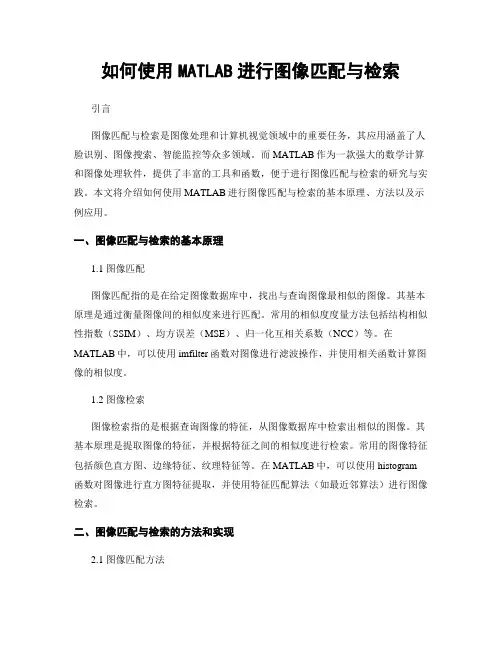
如何使用MATLAB进行图像匹配与检索引言图像匹配与检索是图像处理和计算机视觉领域中的重要任务,其应用涵盖了人脸识别、图像搜索、智能监控等众多领域。
而MATLAB作为一款强大的数学计算和图像处理软件,提供了丰富的工具和函数,便于进行图像匹配与检索的研究与实践。
本文将介绍如何使用MATLAB进行图像匹配与检索的基本原理、方法以及示例应用。
一、图像匹配与检索的基本原理1.1 图像匹配图像匹配指的是在给定图像数据库中,找出与查询图像最相似的图像。
其基本原理是通过衡量图像间的相似度来进行匹配。
常用的相似度度量方法包括结构相似性指数(SSIM)、均方误差(MSE)、归一化互相关系数(NCC)等。
在MATLAB中,可以使用imfilter函数对图像进行滤波操作,并使用相关函数计算图像的相似度。
1.2 图像检索图像检索指的是根据查询图像的特征,从图像数据库中检索出相似的图像。
其基本原理是提取图像的特征,并根据特征之间的相似度进行检索。
常用的图像特征包括颜色直方图、边缘特征、纹理特征等。
在MATLAB中,可以使用histogram 函数对图像进行直方图特征提取,并使用特征匹配算法(如最近邻算法)进行图像检索。
二、图像匹配与检索的方法和实现2.1 图像匹配方法图像匹配方法包括基于特征点的匹配和基于全局特征的匹配。
前者是通过检测图像中的关键点,提取关键点的局部特征,然后通过寻找匹配点来实现图像匹配。
后者是通过提取图像的全局特征,比如颜色、纹理等信息,然后计算图像之间的相似度进行匹配。
在MATLAB中,可以使用SURF算法提取图像的特征点,或者使用Bag of Words(BoW)模型提取图像的全局特征,并通过最近邻算法进行匹配。
2.2 图像检索方法图像检索方法主要包括基于内容的检索和基于语义的检索。
前者是通过提取图像的低级视觉特征,比如颜色、形状等,然后根据相似度进行检索。
后者是通过利用机器学习和自然语言处理技术,将图像关联到语义标签,然后根据语义标签进行检索。
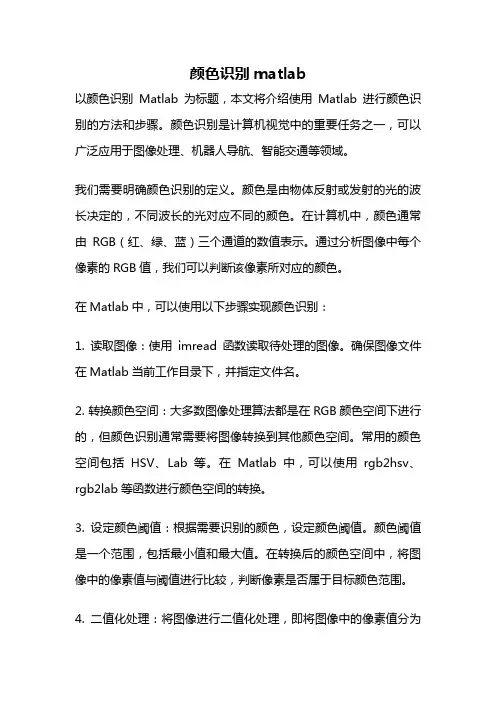
颜色识别matlab以颜色识别Matlab为标题,本文将介绍使用Matlab进行颜色识别的方法和步骤。
颜色识别是计算机视觉中的重要任务之一,可以广泛应用于图像处理、机器人导航、智能交通等领域。
我们需要明确颜色识别的定义。
颜色是由物体反射或发射的光的波长决定的,不同波长的光对应不同的颜色。
在计算机中,颜色通常由RGB(红、绿、蓝)三个通道的数值表示。
通过分析图像中每个像素的RGB值,我们可以判断该像素所对应的颜色。
在Matlab中,可以使用以下步骤实现颜色识别:1. 读取图像:使用imread函数读取待处理的图像。
确保图像文件在Matlab当前工作目录下,并指定文件名。
2. 转换颜色空间:大多数图像处理算法都是在RGB颜色空间下进行的,但颜色识别通常需要将图像转换到其他颜色空间。
常用的颜色空间包括HSV、Lab等。
在Matlab中,可以使用rgb2hsv、rgb2lab等函数进行颜色空间的转换。
3. 设定颜色阈值:根据需要识别的颜色,设定颜色阈值。
颜色阈值是一个范围,包括最小值和最大值。
在转换后的颜色空间中,将图像中的像素值与阈值进行比较,判断像素是否属于目标颜色范围。
4. 二值化处理:将图像进行二值化处理,即将图像中的像素值分为两类:目标颜色范围内的像素和其他像素。
可以使用imbinarize函数实现二值化处理。
5. 进行形态学操作:为了去除图像中的噪声和不连续的区域,可以使用形态学操作进行图像的腐蚀和膨胀。
常用的形态学操作函数包括imerode和imdilate。
6. 进行连通区域分析:使用bwlabel函数对二值化后的图像进行连通区域分析,得到图像中的不同颜色区域。
每个区域被赋予一个标签。
7. 可视化结果:可以使用imshow函数将处理后的图像显示出来,观察颜色识别的效果。
可以使用label2rgb函数将不同的连通区域标签以不同的颜色显示。
通过以上步骤,我们可以在Matlab中实现颜色识别。
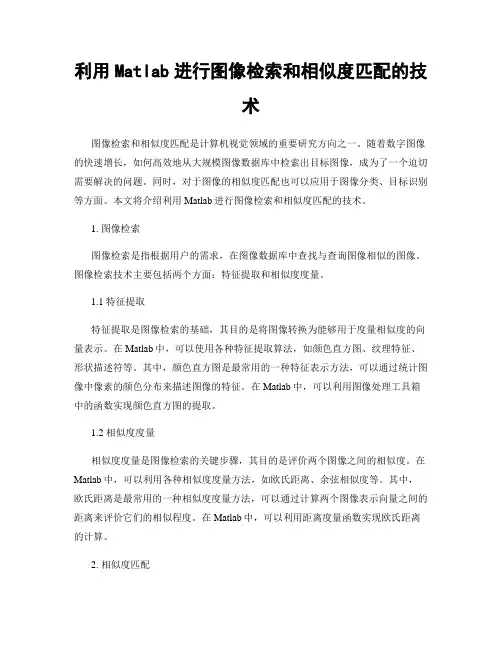
利用Matlab进行图像检索和相似度匹配的技术图像检索和相似度匹配是计算机视觉领域的重要研究方向之一。
随着数字图像的快速增长,如何高效地从大规模图像数据库中检索出目标图像,成为了一个迫切需要解决的问题。
同时,对于图像的相似度匹配也可以应用于图像分类、目标识别等方面。
本文将介绍利用Matlab进行图像检索和相似度匹配的技术。
1. 图像检索图像检索是指根据用户的需求,在图像数据库中查找与查询图像相似的图像。
图像检索技术主要包括两个方面:特征提取和相似度度量。
1.1 特征提取特征提取是图像检索的基础,其目的是将图像转换为能够用于度量相似度的向量表示。
在Matlab中,可以使用各种特征提取算法,如颜色直方图、纹理特征、形状描述符等。
其中,颜色直方图是最常用的一种特征表示方法,可以通过统计图像中像素的颜色分布来描述图像的特征。
在Matlab中,可以利用图像处理工具箱中的函数实现颜色直方图的提取。
1.2 相似度度量相似度度量是图像检索的关键步骤,其目的是评价两个图像之间的相似度。
在Matlab中,可以利用各种相似度度量方法,如欧氏距离、余弦相似度等。
其中,欧氏距离是最常用的一种相似度度量方法,可以通过计算两个图像表示向量之间的距离来评价它们的相似程度。
在Matlab中,可以利用距离度量函数实现欧氏距离的计算。
2. 相似度匹配相似度匹配是指在给定一个查询图像后,从图像数据库中找出与之最相似的图像。
相似度匹配的关键是建立一个高效的索引结构来加速查询过程。
在Matlab中,可以利用各种索引结构,如KD树、LSH等。
其中,KD树是一种常用的索引结构,可以将高维空间划分为多个子空间,通过比较查询图像和数据库图像在子空间的分布情况来确定相似度。
在Matlab中,可以利用KD树算法包建立索引结构,并进行相似度匹配。
3. 实例应用图像检索和相似度匹配技术在实际应用中有着广泛的应用。
例如,在商业领域,可以利用这些技术实现商品的图像搜索,帮助用户更快速地找到所需的商品;在医学领域,可以利用这些技术实现图像的匹配和比对,帮助医生进行疾病的诊断和治疗等。
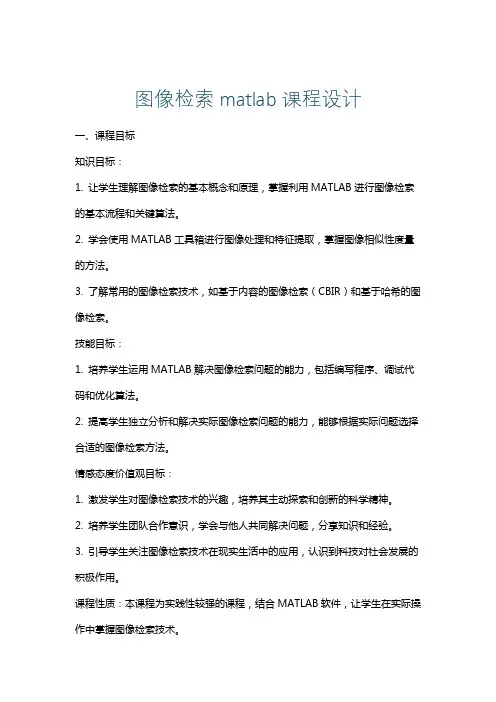
图像检索matlab课程设计一、课程目标知识目标:1. 让学生理解图像检索的基本概念和原理,掌握利用MATLAB进行图像检索的基本流程和关键算法。
2. 学会使用MATLAB工具箱进行图像处理和特征提取,掌握图像相似性度量的方法。
3. 了解常用的图像检索技术,如基于内容的图像检索(CBIR)和基于哈希的图像检索。
技能目标:1. 培养学生运用MATLAB解决图像检索问题的能力,包括编写程序、调试代码和优化算法。
2. 提高学生独立分析和解决实际图像检索问题的能力,能够根据实际问题选择合适的图像检索方法。
情感态度价值观目标:1. 激发学生对图像检索技术的兴趣,培养其主动探索和创新的科学精神。
2. 培养学生团队合作意识,学会与他人共同解决问题,分享知识和经验。
3. 引导学生关注图像检索技术在现实生活中的应用,认识到科技对社会发展的积极作用。
课程性质:本课程为实践性较强的课程,结合MATLAB软件,让学生在实际操作中掌握图像检索技术。
学生特点:学生已具备一定的编程基础和图像处理知识,对MATLAB有一定了解。
教学要求:注重理论与实践相结合,通过案例分析和实际操作,使学生掌握图像检索的核心技术和方法。
同时,注重培养学生的动手能力和实际问题解决能力。
在教学过程中,关注学生的个体差异,提供个性化指导,确保课程目标的实现。
二、教学内容1. 图像检索基本概念与原理- 图像检索的定义与分类- 常用图像检索技术简介2. MATLAB图像处理基础- MATLAB图像处理工具箱介绍- 图像读取、显示和保存- 图像类型转换与数据结构3. 图像特征提取- 颜色特征提取- 纹理特征提取- 形状特征提取- 结构特征提取4. 图像相似性度量- 欧氏距离- 余弦相似性- 马氏距离- 其他相似性度量方法5. 基于内容的图像检索(CBIR)- CBIR系统框架- 特征提取与索引构建- 检索算法与优化6. 基于哈希的图像检索- 哈希算法原理- 常用哈希算法介绍- 哈希图像检索实现7. 课程实践与案例分析- 案例分析:典型图像检索系统- 课程实践:搭建简单的图像检索系统教学内容安排和进度:第1周:图像检索基本概念与原理第2周:MATLAB图像处理基础第3周:图像特征提取第4周:图像相似性度量第5周:基于内容的图像检索(CBIR)第6周:基于哈希的图像检索第7周:课程实践与案例分析教材关联章节:请参考教材《数字图像处理与应用》第3章“图像特征提取与相似性度量”和第4章“图像检索与识别”。

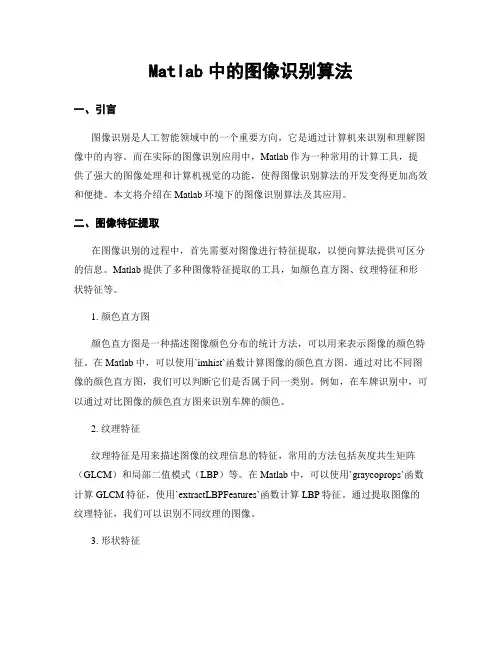
Matlab中的图像识别算法一、引言图像识别是人工智能领域中的一个重要方向,它是通过计算机来识别和理解图像中的内容。
而在实际的图像识别应用中,Matlab作为一种常用的计算工具,提供了强大的图像处理和计算机视觉的功能,使得图像识别算法的开发变得更加高效和便捷。
本文将介绍在Matlab环境下的图像识别算法及其应用。
二、图像特征提取在图像识别的过程中,首先需要对图像进行特征提取,以便向算法提供可区分的信息。
Matlab提供了多种图像特征提取的工具,如颜色直方图、纹理特征和形状特征等。
1. 颜色直方图颜色直方图是一种描述图像颜色分布的统计方法,可以用来表示图像的颜色特征。
在Matlab中,可以使用`imhist`函数计算图像的颜色直方图。
通过对比不同图像的颜色直方图,我们可以判断它们是否属于同一类别。
例如,在车牌识别中,可以通过对比图像的颜色直方图来识别车牌的颜色。
2. 纹理特征纹理特征是用来描述图像的纹理信息的特征,常用的方法包括灰度共生矩阵(GLCM)和局部二值模式(LBP)等。
在Matlab中,可以使用`graycoprops`函数计算GLCM特征,使用`extractLBPFeatures`函数计算LBP特征。
通过提取图像的纹理特征,我们可以识别不同纹理的图像。
3. 形状特征形状特征是用来描述图像物体形状的特征,常用的方法包括轮廓特征和区域特征等。
在Matlab中,可以使用`bwboundaries`函数计算图像的边界轮廓,使用`regionprops`函数计算图像的区域特征。
通过提取图像的形状特征,我们可以识别不同形状的物体。
三、图像识别算法在进行特征提取后,接下来需要使用分类算法来进行图像识别。
Matlab提供了丰富的分类算法,包括支持向量机(SVM)、人工神经网络(ANN)和深度学习等。
1. 支持向量机支持向量机是一种常用的分类算法,它通过构建一个高维空间的超平面来实现对不同类别的图像进行分类。
Web图像检索系统原型设计和实现摘要计算机处理能力的日益增强,因特网技术的广泛普及和网络带宽不断提高,大量的图像信息不断产生,如何从这些海量图像数据中搜索人们感兴趣并有效利用这些图像,成为迫切需要解决的问题.本设计介绍了在web中检索图像的基本概念和常用的重要技术,并简要阐述了它们的基本概念、原理,说明了目前这一领域的发展现状。
本文介绍了图像的特征:颜色特征、纹理特征和形状特征,和以图像内容特征为基础的Web图检索原理。
最后以基于内容的图像检索为重点,利用Matlab对Web图像检索系统进行了模拟和验证。
我的工作是Web图像检索系统原型的架构和检索界面的设计和实现,利用matlab gui设计系统界面以实现图像的检索功能。
关键字:Web图象检索,特征提取,Matlab GUIAbstractWith the capacity of computer increasing , Internet technology is popular more and more。
A mass of image data informations is produced constantly,so image retrieval becomes a urgent problem.Firstly, the basic concept of Web image retrieval and some technologys are introduced in the paper; secondly we describes the image features:color feature,texton feafure,shape feafure. the theory of Web image retrieval is based on these content features. Meanwhile ,several important image retrieval algorithms are introduced and compared in the paper. Finally, we made experiment on Matlab for web image retrieval 。
如何使用Matlab进行图像检索与内容识别近年来,随着图像数据的爆发式增长,图像检索与内容识别成为计算机视觉领域的研究热点。
而Matlab作为一种功能强大的编程环境和开发工具,具备着广泛的应用前景。
本文将重点探讨如何使用Matlab进行图像检索与内容识别。
一、图像检索图像检索是通过查询来寻找与目标图像具有相似特征或内容的图像。
根据不同的需求,可以分为基于内容的图像检索和基于示例的图像检索。
而基于内容的图像检索则首先需要提取图像的特征。
1. 特征提取特征提取是图像检索中非常关键的一步。
Matlab提供了许多函数和工具箱来进行特征提取。
例如,可以使用颜色直方图、纹理特征、形状特征等来描述图像的内容。
一个常用的特征提取方法是将图像转换为灰度图像,然后使用灰度共生矩阵(Gray Level Co-occurrence Matrix,GLCM)来提取纹理特征。
2. 相似度度量在图像检索中,相似度度量是判断两幅图像之间相似程度的重要指标。
常用的相似度度量方法包括欧氏距离、曼哈顿距离、余弦相似度等。
在Matlab中,可以使用函数`pdist`和`squareform`来计算两个特征向量之间的距离,并将距离矩阵转换为距离矩阵。
3. 数据索引与查询在特征提取和相似度度量后,接下来需要对图像进行索引和查询。
可以使用Matlab提供的数据结构和算法来建立索引和查询图像数据库。
例如,可以使用KD 树、LSH等方法来快速定位相似图像。
同时,也可以使用内容相关的关键字或标签对图像进行索引和查询。
二、内容识别内容识别是根据图像的内容或目标来判断图像所属的类别或属性。
常见的内容识别任务包括图像分类、目标检测和图像分割等。
Matlab提供了许多功能强大的工具箱和函数来进行内容识别。
1. 特征选择特征选择是内容识别中一个重要的步骤。
可以根据不同的任务和数据集选择合适的特征。
例如,在图像分类任务中,可以使用SIFT、HOG等特征描述子。
Matlab技术在图像检索中的应用近年来,随着计算机视觉和人工智能的快速发展,图像检索成为一项备受关注的技术。
图像检索技术的目标是通过计算机对大量图像进行分析和处理,使用户能够通过输入查询图像,从数据库中快速检索出与查询图像相似的图像。
而Matlab作为一种功能强大的科学计算软件,被广泛应用于图像处理与分析领域。
本文将详细介绍Matlab技术在图像检索中的应用,并探讨其在算法、特征提取和性能优化等方面的重要性。
一、图像检索算法图像检索技术的核心在于设计高效的检索算法。
Matlab提供了丰富的图像处理和计算工具箱,使得图像检索算法的设计和实现变得更加容易。
对于基于内容的图像检索(Content-based image retrieval,CBIR)来说,常用的算法包括颜色直方图、纹理特征和形状描述等。
在Matlab中,我们可以利用图像处理工具箱提取图像的颜色直方图,并通过直方图匹配算法来计算图像相似度。
此外,Matlab还提供了强大的图像处理函数,如均值滤波器和高斯滤波器,可用于图像的平滑处理和纹理特征提取。
这些算法的实现不仅简单高效,而且易于和其他计算模块结合,为图像检索系统的开发提供了良好的基础。
二、特征提取与表示在图像检索中,如何快速有效地提取和表示图像的特征是一个关键问题。
特征提取可以从图像中提取出能够表征其内容的信息,例如颜色、纹理和形状等。
而特征表示则是将提取出的特征转化为特征向量或特征描述符,以便计算机进行进一步处理和分析。
Matlab提供了各种图像特征提取和表示方法的函数和工具箱,如SIFT、SURF和HOG等。
这些方法在图像检索中广泛应用,并取得了显著的效果。
使用Matlab提供的特征提取函数,我们可以从图像中提取出丰富的特征,并通过算法进行降维和聚类,从而实现图像的高效检索。
三、性能优化图像检索是一个计算量较大的任务,尤其是在大规模图像数据库的情况下。
为了提高图像检索系统的性能,我们需要对算法进行优化和加速。
如何使用Matlab进行图像识别和图像分类技术实现在数字化时代,图像处理和图像识别已经成为我们生活中不可或缺的一部分。
随着人工智能和机器学习的迅速发展,使用机器来处理和识别图像已经变得越来越普遍。
Matlab作为一种功能强大的编程语言和数据处理环境,为我们提供了丰富的工具来实现图像识别和分类。
本文将介绍如何使用Matlab进行图像识别和分类技术的实现。
一、图像预处理在进行图像识别和分类之前,首先需要对图像进行预处理。
图像预处理的目的是消除图像中的噪声和不必要的信息,从而使得后续的识别和分类工作更加准确和可靠。
常见的图像预处理方法包括图像去噪、图像增强、图像缩放等。
1. 图像去噪图像去噪是为了减少图像中的噪声,使得图像更加清晰和可辨认。
常见的图像去噪方法有中值滤波、均值滤波和高斯滤波等。
在Matlab中,可以使用imfilter函数来实现这些滤波操作。
2. 图像增强图像增强是为了使得图像更加鲜明和有区分度。
常见的图像增强方法有直方图均衡化、对比度增强和边缘增强等。
在Matlab中,可以使用imadjust函数和histeq 函数来实现这些增强操作。
3. 图像缩放图像缩放是为了统一不同大小的图像,使得它们具有相同的尺寸。
在Matlab 中,可以使用imresize函数来实现图像的缩放操作。
二、特征提取在进行图像识别和分类之前,需要从图像中提取出有用的特征。
特征提取是将图像中的信息转化为数值特征向量的过程,这些特征向量可以用来描述图像的内容和特征。
常见的特征提取方法有颜色特征、纹理特征和形状特征等。
1. 颜色特征颜色特征是指图像中的颜色分布和色彩特征。
在Matlab中,可以使用rgb2hsv 函数将RGB图像转换为HSV颜色空间,从而提取出颜色特征。
2. 纹理特征纹理特征是指图像中纹理的分布和特征。
常见的纹理特征提取方法有灰度共生矩阵(GLCM)和局部二值模式(LBP)等。
在Matlab中,可以使用graycomatrix函数和lbp函数来实现这些纹理特征的提取。
如何利用Matlab进行图像识别图像识别是计算机视觉领域中的重要应用之一,它可以使计算机通过分析图像内容来判断图像所代表的实体或场景。
近年来,随着人工智能和深度学习算法的发展,图像识别的准确性和性能得到了显著提高。
在本文中,我们将介绍如何利用Matlab进行图像识别,并提供一些常用的图像处理和机器学习方法。
一、图像处理预处理图像处理预处理是图像识别的第一步,它主要用于改善图像质量和特征提取。
在Matlab中,可以使用各种图像处理函数来实现预处理操作,例如图像去噪、图像增强和图像分割。
以下是一些常见的图像处理预处理方法:1. 图像去噪图像去噪是指通过滤波算法来减少图像中的噪声。
在Matlab中,可以使用中值滤波、高斯滤波等滤波方法来实现图像去噪,以提高图像质量。
2. 图像增强图像增强是指通过图像处理算法来改善图像的视觉效果。
在Matlab中,可以使用直方图均衡化、对比度增强等方法来实现图像增强,以提供更好的图像特征。
3. 图像分割图像分割是将图像分解成一些具有独立意义的区域的过程。
在Matlab中,可以使用阈值分割、边缘检测等方法来实现图像分割,以便更好地提取图像特征。
二、特征提取特征提取是图像识别的关键步骤,它通过对图像进行灰度、颜色、纹理等特征的提取,将图像转化为能够表示和区分不同类别的特征向量。
在Matlab中,可以使用各种特征提取算法来实现特征提取,例如局部二值模式(LBP)、方向梯度直方图(HOG)等。
以下是一些常见的图像特征提取方法:1. 灰度特征灰度特征是指通过对图像的灰度值进行统计和分析来提取的特征。
在Matlab 中,可以使用灰度共生矩阵(GLCM)、灰度直方图等方法来提取灰度特征。
2. 颜色特征颜色特征是指通过对图像颜色分布进行统计和分析来提取的特征。
在Matlab 中,可以使用颜色直方图、颜色矩等方法来提取颜色特征。
3. 纹理特征纹理特征是指通过对图像纹理结构进行统计和分析来提取的特征。
Matlab中的图像分析与识别方法探究引言:随着计算机视觉技术的快速发展,图像分析与识别作为一种重要的应用领域越来越受到关注。
Matlab作为一种强大的科学计算软件,为图像分析与识别提供了丰富的功能和工具。
本文将探讨Matlab中一些常用的图像分析与识别方法,旨在帮助读者更好地理解和应用这些技术。
一、图像预处理图像预处理是图像分析与识别的第一步,目的是通过一系列的处理操作来改善图像的质量和信息。
常用的预处理技术包括灰度转换、直方图均衡化、滤波和边缘检测等。
1. 灰度转换灰度转换是将彩色图像转换为灰度图像的过程,常用的方法有平均法、最大值法和最小值法。
通过灰度转换,我们可以将彩色图像转换为灰度图像,从而方便后续的处理和分析。
2. 直方图均衡化直方图均衡化是一种常用的图像增强技术,它可以通过调整图像中像素的灰度分布来增强图像的对比度和细节。
Matlab提供了histeq函数来实现直方图均衡化,使用简单方便。
3. 滤波滤波是一种常用的图像平滑技术,通过滤波可以去除图像中的噪声和其他不需要的细节。
Matlab提供了各种滤波器的函数,如均值滤波器、中值滤波器和高斯滤波器等。
选择不同的滤波器可以实现不同的效果,根据实际需求进行选择。
4. 边缘检测边缘检测是一种常用的图像特征提取技术,它可以通过检测图像中的边缘来寻找物体的轮廓。
Matlab提供了多种边缘检测算法的函数,如Sobel算子、Prewitt算子和Canny算法等。
根据图像的特点和需求选择不同的算法来进行边缘检测。
二、特征提取与选择在图像分析与识别中,特征提取与选择是非常重要的步骤。
通过提取和选择适当的特征,可以减少数据的维度,并且更好地表示图像的特征。
常用的特征包括形状特征、纹理特征和颜色特征等。
1. 形状特征形状特征是描述物体形状特点的特征,可以通过计算物体的轮廓或边缘来获得。
Matlab提供了多种形状特征提取的函数,如Hu矩、傅里叶描述子和Zernike矩等。
Prototyping Color-based Image Retrieval with MATLAB® Petteri Kerminen1, Moncef Gabbouj21Tampere University of Technology, Pori, Finland 2Tampere University of Technology, Signal ProcessingLaboratory, Tampere, FinlandAbstractContent-based retrieval of (image) databases has become more popular than before. Algorithm develop-ment for this purpose requirestesting/simulation tools,but there are no suitable commercial tools on the market.A simulation environment for retrieving images from database according histogram similarities is presented in this paper. This environment allows the use of different color spaces and numbers of bins. The algorithms are implemented with MATLAB. Each color system has its own m-files.The phases of the software building process are pre-sented from system design to graphical user interface (GUI). The functionality is described with snapshots of GUI.1. IntroductionNowadays there are thousands or hundreds of thousands of digital images in an image database. If the user wants to find a suitable image for his/her purposes, he/she has to go through the database until the correct image has been found or use a reference book or some “intelligent” program. Video on demand (VoD) services also requires an intelligent search system forend-users. VoD systems’ search methods differ slightly from image database’s methods.A reference book is a suitable option, if the images are arranged with a useful method, for example: 1)categories: animals, flags, etc, 2) names (requires a good naming technique) or 3) dates. An experienced user can use these systems as well as textual searches (keywords have to be inserted in a database) efficiently. There are situations when a multi-language system has to be used. There a language independent search system’s best properties can be utilized. A tool which is based on the images’ properties can be madelanguage independent. These properties can be for example color, shape, texture, spatial location of shape etc.In the MuVi-project [1] this kind of tool is under construction. It will cover the properties presented above.Research work on content-based image retrieval has been done in [2 – 6]. The system, which is presented in this paper, is a simulation environment, where MuVi’s color content based retrieval has been developed and tested.2. System developmentMATLAB is an efficient program for vector and matrix data processing. It contains ready functions for matrix manipulations and image visualization and allows a program to have modular structure. Because of these facts MATLAB has been chosen as prototyping software.2.1 System designBefore any m-files have been written, the system designhas been done. A system design for the HSV (hue, saturation and value) color system based retrieval process is presented in Figure 1. Similar design has been done for all used color systems.Figure 1: Function chart for HSV color space with 27 bins histogram.T esths27 is the main function for this color system and this number of bins. It calls other functions(hs27read, dif_hsv and image_pos) when needed. Each color system has a main function of its own and variable number (2 – 3) of sub-functions. If there is no need for color space conversion there are 2 functions,otherwise 3 functions on the first branch of the function chart.The function call of the main function is:matches=tesths27(imagen,directory,num)The variable imagen specifies the query image’s name and path. The directory is a path of the image database and num is a desired number of retrieved images.2.2 FunctionsAt this moment there are functions implemented for four color spaces: HSV, L*a*b*, RGB and XYZ [7]. Each color space has from 2 to 4 implementations for different numbers of bins. There are altogether 14 main functions.For some color systems it is possible to make these functions dynamic, i.e. dynamic histogram calculation. Every color system / bin combination requires its own histograms and these can be made only with an exhaustive method (pixel by pixel). Histogram calculation takes ½ - 5 minutes per image, each approximately 320×240 pixels, depending on the complexity of the color space on 150 MHz Pentium. Thus it is not reasonable to let the user select a bin number freely, especially in the case of large databases.The functions have been named so that the names contain information of the color space used, the purpose of the functions and the number of used bins. Some functions, for example image_pos, have been used by many or all main functions and these functions have not been named as described above.The main function checks, if the function call is correct. If the query image’s name doesn’t contain a path, the function assumes that the image is situated in the database directory. In addition to this, the main function checks,if the query image already has a histogram in the currently used database. If the required histogram is not there, the image read (for example hs27read) function is called. This function also normalizes pixel values and arranges image matrix data to a vector format. After that stage a color space conversion function (if needed) is called. Finally a quantization function builds the histogram with the correct number of bins.The histogram will then be saved into the database directory. If the histogram already exists there, the three previous steps will not be executed. Now the query image has been analyzed. Then the main function will go through all images in the database directory with an almost similar algorithm as in the case of the query image. The difference is that now there will be a histogram difference calculation between the query image’s and current image’s histogram. Finally the image_pos function will be used to put a query image and the desired number of best match images on the display.2.3 LinkingIt is not possible to use a program before the main function andsub-functions are connected to each other. The main function will be called from the command line or through the graphical user interface, which will be presented later in this paper. In both cases the function call will contain the same arguments. For multi-level search purposes separate main functions have been implemented, but it is possible to utilize “normal” functions and add one parameter, where the best matches array can be transferred for second a stage comparison function.The main function calls an image read function with the image’s name. The histogram will be returned to the main function. If a color space conversion is needed, the conversion function will be called from the read function with r, g and b –vectors. The histogram will be returned to the calling function. Finally the histogram build function will be called with converted color vectors. This function returns a quantized histogram, which will go through allfunctions until it achieves the main function.The main function calls the histogram difference function with two histogram vectors and will get a difference value as a response. The difference function uses Euclidean-distance calculation, but it can be easily changed to another algorithm due to the modularity of the program. If the difference is smaller than largest difference on a best match table, the current result will be written over the last result on the best match table. After that the table is arranged again in an ascending order of distance. When all the images have been analyzed, the sorted best match table, the number of desired output images, the query image’s name, the search image’s path and the database path are transferred to the image_pos function. These values can be transferred into larger components (vectors/containers). Now the program works faster with several input arguments, because there is no need for picking up variables from a container.2.4 Graphical user interfaceThe graphical user interface (GUI) is an important part of software development. The designing of the GUI have to solve the following problems: learning time, speed of performance, rate of errors by users, retention over time, and subjective satisfaction [9]. This software is, at the moment, intended to be used only for testing purposes. The most important property of this software is that the results of different test queries can be seen quickly and the results can be saved safely on a disk. Thus the visual layout is not as important as in case of a commercial software product.In Figure 2 the first screen on GUI is presented. The purposes of the buttons, menus and other components will be presented later. If this software is developed into a commercial product, the menu bar will be disabled in the future and the exit and help buttons will be added on the canvas.Figure 2: GUI before the search image selection.In Figure 3 the search screen is presented just before starting a search. The user is shown a search image,and in this way he/she can be sure that the search will be made with the correct image.Figure 3: GUI just before running a query.The results of the query will be presented on the screen in the format which is presented in Figure 6.3. Using the softwareThe first screen has already been presented in Figure 2. The user can choose from pop-up menus (see Figure 4), if the search is made with one a color system or as a multi-level search. In a one-level search a roughly quantized or a more accurate histogram is used in one loop (one color system).Figure 4: Color system selection from a popup menu.The second menu is disabled because a one-level search is selected.In a multi-level search two different color systems /histograms are used. During the first loop the roughly quantized histograms are used and during the second loop.the more accurate histograms are utilized for the best matches from the first loop. The color system on the second loop can be either the same as on the first loop or a different one. For queries with one-level search the selection of a second color system is disabled. The user can select the number of retrieved images at the final stage. The software can be linked to many image databases and the user can select a database where the query will be directed.The user can select a search image either from the same database where the query will be directed to (default) or from any directory in his/her PC. The selection will be made with the file – open dialog, which is presented inFigur e 5. The form can be cleared with the “Reset” button. A query is executedwith the “Search” button. Finally the results of the search will appear on the screen in a separate window, as presented in Figure 6. Earlier [8] the software opened each image in a separate window and evaluating/saving the results is more difficult than after the improvement. In the top left top corner is the original query image. Below that image the best matches are presented in a descending order of similarity from left to right and from top to bottom. The user can select suitable images for further use with the “Copy selected” or the “Print selected” buttons. The “New search” button closes this form and goes back to the original search form. The “Search similar” button executes a new search where a query histogram is composed of histograms of the selected images. If the user has selected a larger number than 21 as “Number of matching images”, the best matches will be shown on multiple screens. The user can browse these pages with t he “Previous page” and “Following page”buttons.Figure 5: The query image selection dialog. The language of the dialog depends on the language of the operating system used.Figure 6: The results of a query will be presented graphically.4. SummaryThe color content-based retrieval requires algorithms, which give visually correct results. Correctly working algorithms can not be chosen before simulations. The software presented in this paper is intended to be usedfor testing purposes. Some operations will be implemented, if the software is developed into a commercial product. Some modifications are under construction.This software has been used as a testing platform for histogram quantization tests. The modularity of this program makes it possible to take new algorithms as a part of the software in a short time. MATLAB makes quick prototyping possible. A possibility to save figures (search results) directly on a disk is a fulfillment of the program’s requirements. After the results have been analyzed visually, the best algorithms will be taken as a part of the final software.5. AcknowledgementsThis work has been founded by the European Union– ERDF, theT echnology Development Centre T ekes, Alma Media, the Helsinki T elephone Company, Nokia Research Center, the Satakunta High T echnology Foundation and Ulla Tuominen’s Foundation.References[1] Alaya Cheikh F et. al. MUVIS: A System for Content-Based Indexing and Retrieval in Large Image Databases. Proceedings of SPIE Storage and Retrieval for Image and Video Databases, San Jose, 1999,vol. 3656: 98 – 106.[2] Sawhney H. S., Hafner J. L., Efficient Color Histogram Indexing for Quadratic Form Distance Functions, IEEE Transactions on Pattern Analysis and Machine Intelligence, 1995, vol. 17 no. 7: 729 – 736.[3] Vellaikal A. et. al. Content-Based Retrieval of Color and Multispectral Images Using Joint Spatial-Spectral Indexing, SPIE vol. 2606: 232 – 243.[4] Ng V. et. al. Adaptive Histogram Indexing, SPIE vol. 2606: 202 – 211.[5] Smith J. R., Chang S. F. Automatic Image Retrieval Using Color andT exture, 1995-6,/~jrsmith/html/pubs/PAMI/pami_final_1.htm.[6] Flickner M. et. al. Query by Image and Video Content: The QBIC System, IEEE Computer 1995 vol. 28 no. 9: 23 – 32.[7] Jain A. K. Fundamentals of Digital Image Processing, Prentice Hall, 1989: 66 - 71.[8] Kerminen P, Gabbouj M. Image Retrieval Based on Color Matching. Proceedings of FINSIG’99, Oulun yliopistopaino, 1999: 89 – 93.[9] Shneiderman B. Designing the User Interface, AddisonWesley Longman, 1998: 14 – 16.原型基于颜色的图像检索与MATLAB ®Petteri Kerminen1,Moncef Gabbouj21坦佩雷理工大学,波里,芬兰2坦佩雷理工大学,信号处理实验室,坦佩雷,芬兰摘要基于内容的检索数据库(图像)已经变得越来越受欢迎。